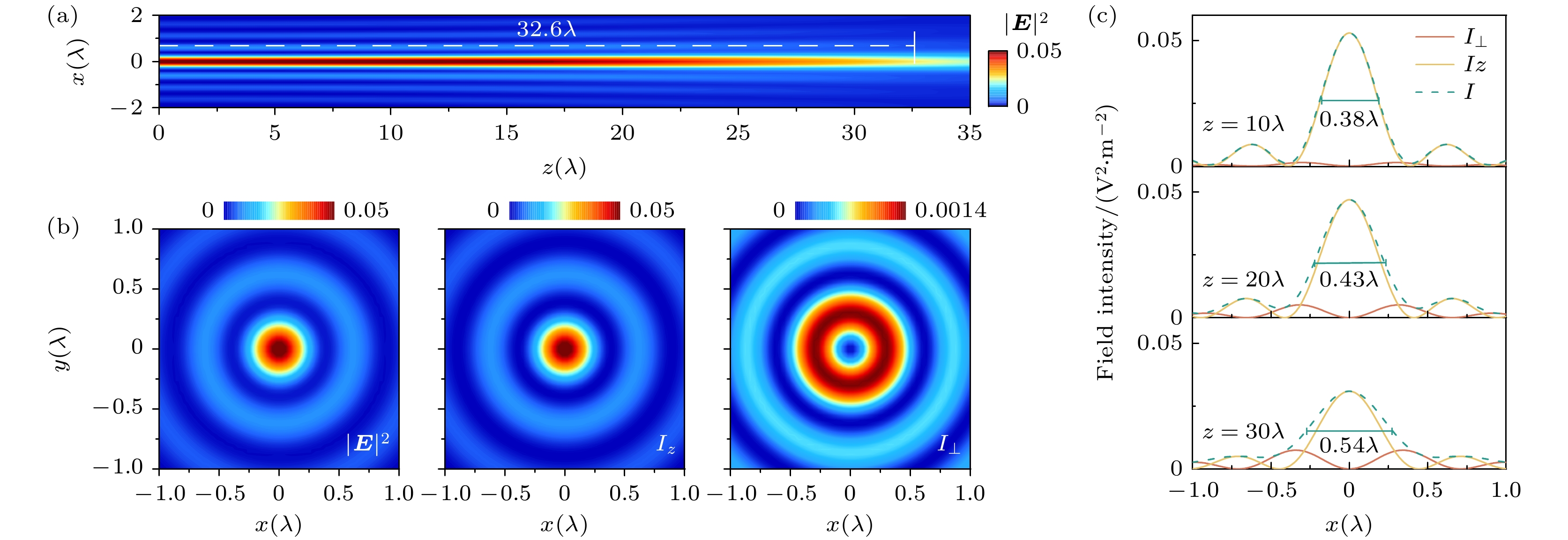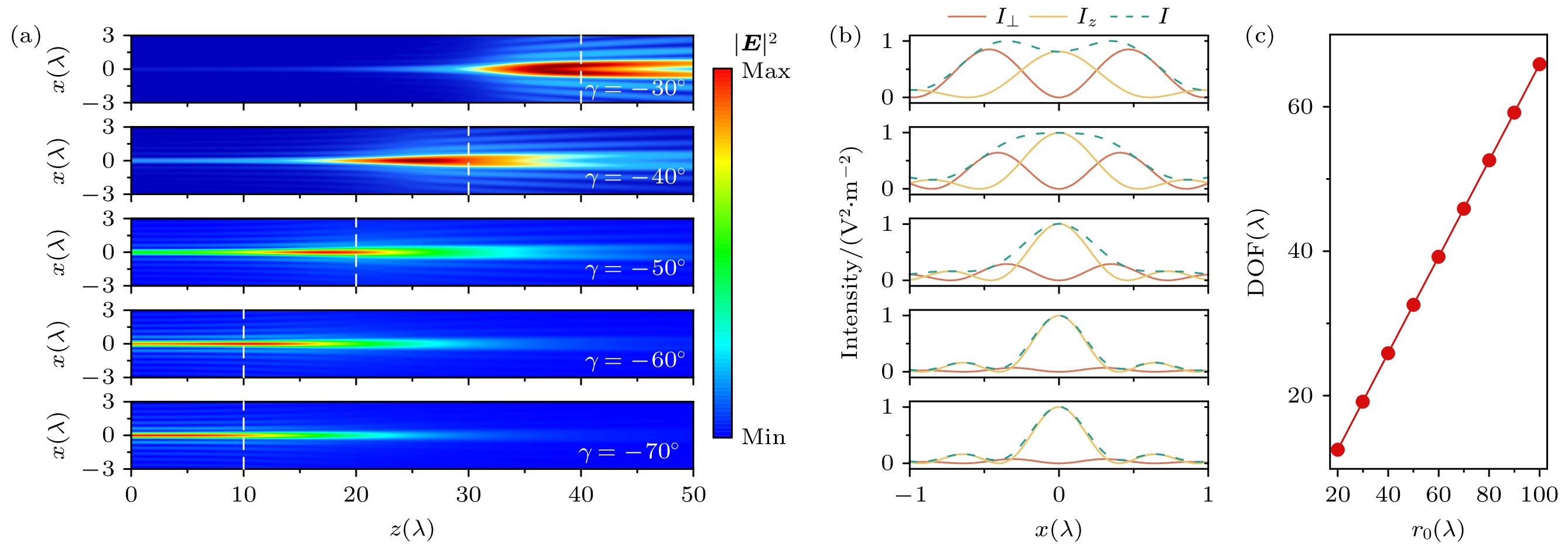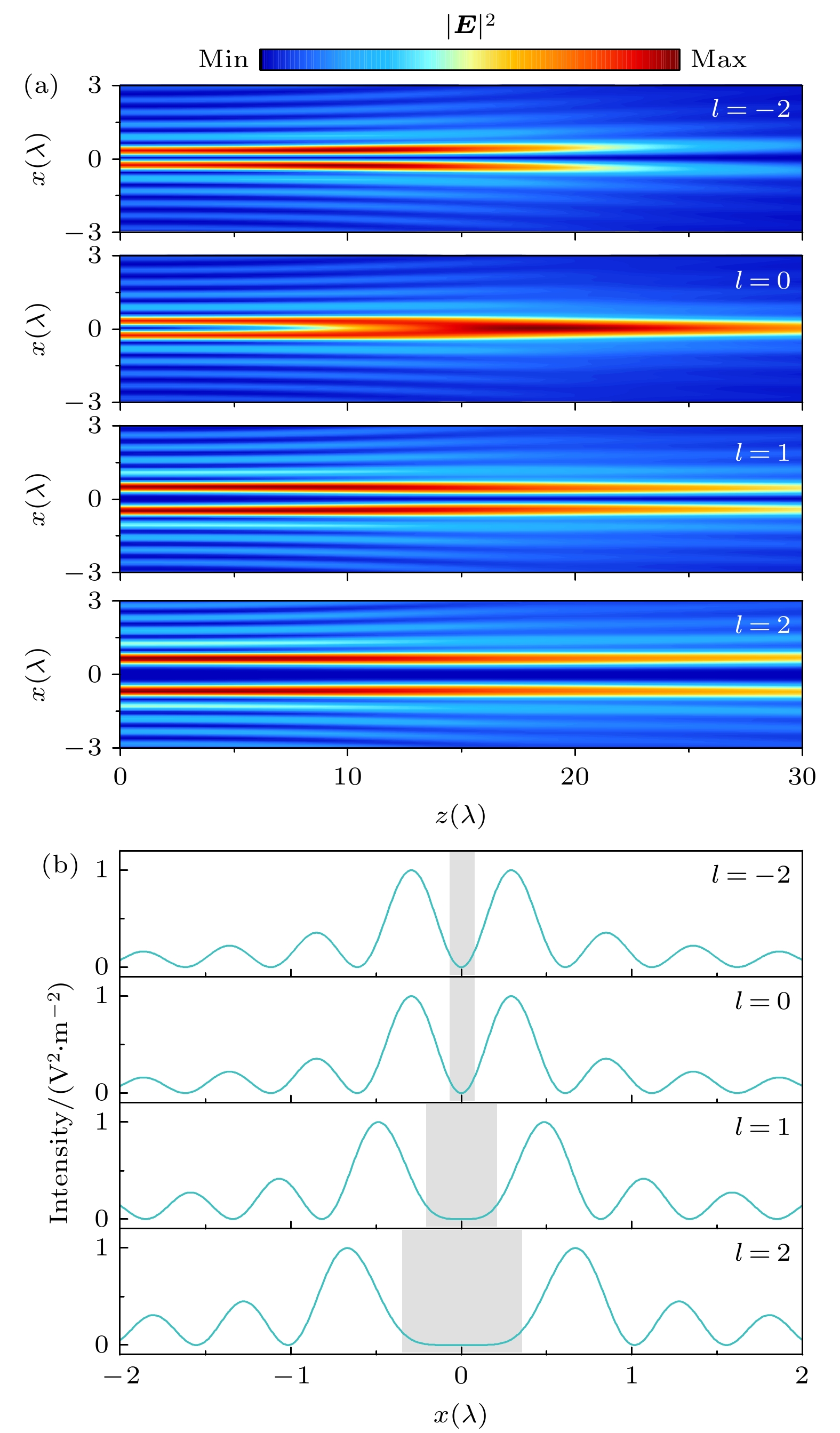-
光学针是一种特殊的空间光场分布, 具有极小的横向光斑尺寸, 可以突破衍射极限, 同时在纵向上拥有较长的焦深. 光学针通常利用透镜对光束进行紧聚焦来产生, 本文利用圆艾里光束固有的自聚焦特性来构建光学针. 研究结果表明, 锥角调制的圆偏振圆艾里涡旋光束在选取合适的拓扑荷后, 可以产生光学针. 这是因为在锥角调制下, 光束的纵向分量被显著增强, 而纵向分量光场具有极小的横向光斑尺寸. 光学针的焦深与光束的主环半径近似呈线性关系, 因此增大主环半径可以有效增强光学针的焦深. 此外, 具有不同拓扑荷的圆艾里涡旋光束可以构建出不同结构的空间光场. 本文的研究有望在超分辨成像和光学微操控等领域具有潜在应用价值.An optical needle is a specialized spatial light field characterized by an extremely small transverse spot size, capable of breaking through the diffraction limit, and also prossessing a long focal depth in the longitudinal direction. Typically, optical needles are generated by tightly focusing a beam using a lens. In this work, the generation of optical needles is demonstrated by using circular Airy vortex beams (CAVBs) through adjusting the conical angle. The CAVBs have a uniform distribution of circular polarization, thus eliminating the need for radial polarization states. Our research indicates that under the conical angle modulation, CAVBs with a topological charge of –1 (left-handed circular polarization) and 1 (right-handed circular polarization) can form optical needles. These optical needles possess a minimal transverse spot size, enabling them to exceed the diffraction limit while maintaining a long depth of focus. Furthermore, the depth of focus of the optical needle is almost linearly related to the primary ring radius of the beam. Increasing the primary ring radius can effectively enhance the depth of focus. CAVBs with different topological charges generate distinct hollow light fields, unlike optical needles. This is because the longitudinal component of the light beam is significantly enhanced by adjusting the conical angle. Only CAVBs with the appropriate topological charge exhibit a longitudinal light field near the optical axis, leading to the formation of optical needles. In contrast, other charges result in a hollow longitudinal light field, creating different hollow light fields. These research findings could have significant applications in super-resolution imaging and optical micromanipulation.
-
Keywords:
- optical needle /
- circular Airy beam /
- optical vortex /
- optical modulation
[1] Efremidis N K, Christodoulides D N 2010 Opt. Lett. 35 4045
 Google Scholar
Google Scholar
[2] Lu W, Sun X, Chen H, Liu S, Lin Z 2019 Phys. Rev. A 99 013817
 Google Scholar
Google Scholar
[3] Efremidis N K 2011 Opt. Lett. 36 3006
 Google Scholar
Google Scholar
[4] Chremmos I, Efremidis N K, Christodoulides D N 2011 Opt. Lett. 36 1890
 Google Scholar
Google Scholar
[5] Chremmos I D, Chen Z, Christodoulides D N, Efremidis N K 2012 Phys. Rev. A 85 023828
 Google Scholar
Google Scholar
[6] Jiang Y, Zhu X, Yu W, Shao H, Zheng W, Lu X 2015 Opt. Express 23 29834
 Google Scholar
Google Scholar
[7] Sun X, An Z, Lu W 2020 IEEE Photonics J. 12 1
[8] Hwang C Y, Kim K Y, Lee B 2012 IEEE Photonics J. 4 174
 Google Scholar
Google Scholar
[9] Zhong H, Zhang Y, Belić M R, Li C, Wen F, Zhang Z, Zhang Y 2016 Opt. Express 24 7495
 Google Scholar
Google Scholar
[10] Davis J A, Cottrell D M, Sand D 2012 Opt. Express 20 13302
 Google Scholar
Google Scholar
[11] Jiang Y, Huang K, Lu X 2012 Opt. Express 20 18579
 Google Scholar
Google Scholar
[12] Dai H T, Liu Y J, Luo D, Sun X W 2010 Opt. Lett. 35 4075
 Google Scholar
Google Scholar
[13] Zhang P, Prakash J, Zhang Z, Mills M S, Efremidis N K, Christodoulides D N, Chen Z 2011 Opt. Lett. 36 2883
 Google Scholar
Google Scholar
[14] Jiang Y, Huang K, Lu X 2013 Opt. Express 21 24413
 Google Scholar
Google Scholar
[15] Panagiotopoulos P, Papazoglou D, Couairon A, Tzortzakis S 2013 Nat. Commun. 4 2622
 Google Scholar
Google Scholar
[16] Manousidaki M, Papazoglou D G, Farsari M, Tzortzakis S 2016 Optica 3 525
 Google Scholar
Google Scholar
[17] Efremidis N K, Paltoglou V, von Klitzing W 2013 Phys. Rev. A 87 043637
 Google Scholar
Google Scholar
[18] Jiang X, Li Y, Ta D, Wang W 2020 Phys. Rev. B 102 064308
 Google Scholar
Google Scholar
[19] Liu K, Koulouklidis A D, Papazoglou D G, Tzortzakis S, Zhang X C 2016 Optica 3 605
 Google Scholar
Google Scholar
[20] Liu S, Wang M, Li P, Zhang P, Zhao J 2013 Opt. Lett. 38 2416
 Google Scholar
Google Scholar
[21] An Z, Lu W 2024 Opt. Lett. 49 642
 Google Scholar
Google Scholar
[22] Wang H, Shi L, Lukyanchuk B, Sheppard C, Chong C T 2008 Nat. Photonics 2 501
 Google Scholar
Google Scholar
[23] Zhan Q 2009 Adv. Opt. Photonics 1 1
 Google Scholar
Google Scholar
[24] Dehez H, April A, Piché M 2012 Opt. Express 20 14891
 Google Scholar
Google Scholar
[25] Wang F, Zhao C, Dong Y, Dong Y, Cai Y 2014 Appl. Phys. B 117 905
 Google Scholar
Google Scholar
[26] Lu W, Chen H, Liu S, Lin Z 2022 Phys. Rev. A 105 043516
 Google Scholar
Google Scholar
[27] Novotny L, Hecht B 2006 Principles of Nano-optics (Cambridge: Cambridge University Press) pp38–41
-
图 1 左旋圆偏振CAVBs的光场强度$ | {\boldsymbol{E}}|^2 $分布 (a) 锥角$ \gamma = 0^\circ $; (b) 锥角$ \gamma = -30^\circ $. (c) 图(b)中沿z轴光场强度的横向分量$ I_\bot $与纵向分量$ I_z $的分布. 所用参数$ E_0 = 1 $ V/m, 波长$ \lambda = 0.532 $ μm, 主环半径$ r_0 = 10\lambda $, 主环宽度$ w_0 = 1.5\lambda $, 衰减因子$ \alpha_{\mathrm{c}} = 0.08 $, 以及拓扑荷$ l = -1 $
Fig. 1. Distribution of the field intensity $ | {\boldsymbol{E}}|^2 $ of circularly polarized CAVBs with conical angles (a) $ \gamma = 0^\circ $ and (b) $ \gamma = -30^\circ $. (c) Profiles of field intensity $ I_\bot $ and $ I_z $ along z-axis corresponding to panel (b). The parameters are given by $ E_0 = 1 $ V/m, the wavelength $ \lambda = 0.532 $ μm, the primary ring radius $ r_0 = 10\lambda $, the primary ring width $ w_0 = 1.5\lambda $, the decay parameter $ \alpha_{\mathrm{c}} = 0.08 $, and the topological charge $ l = -1 $.
图 2 基于拓扑荷为$ l = -1 $的左旋圆偏振CAVBs构建光学针 (a) 光学针的光场强度$ | {\boldsymbol{E}}|^2 $在x-z平面内的分布; (b) 光学针的光场强度$ I = | {\boldsymbol{E}}|^2 $, 以及纵向光强分量$ I_z $和横向光强分量$ I_\bot $在x-y平面内的分布, 对应的传播距离为$ z = 10\lambda $; (c) 不同传播距离处, 光学针的光强度I, $ I_z $及$ I_\bot $沿x轴的分布. 这里光束的锥角$ \gamma = -65^\circ $, 主环半径$ r_0 = 50\lambda $, 其余参数与图1相同
Fig. 2. Optical needle structured via left circularly polarized CAVBs with the topological charge $ l = -1 $: (a) Optical intensity $ | {\boldsymbol{E}}|^2 $ along the x-z plane; (b) profile of intensity $ I = | {\boldsymbol{E}}|^2 $, longitudinal intensity $ I_z $ and transverse intensity $ I_\bot $ along the x-y plane of the optical needle with the propagation distance $ z = 10\lambda $; (c) distributions of the intensity I, transverse intensity $ I_\bot $ and longitudinal intensity $ I_z $ along x-axis with different propagation distance. The conical angle is $ \gamma = -65^\circ $ and the primary ring radius $ r_0 = 50\lambda $, and other parameters are the same as those in Fig. 1.
图 3 左旋圆偏振CAVBs构建的光学针受锥角γ的调制, 光束的主环半径$ r_0 = 30\lambda $, 拓扑荷$ l = -1 $ (a) 不同锥角调制下的CAVBs在x-z平面内的光强度分布; (b) 不同锥角下, CAVBs的光强I及其分量$ I_\bot $与$ I_z $沿x轴的分布, 对应的传播距离z在(a)图中使用白色虚线标出; (c) 光学针的焦深随主环半径$ r_0 $的变化关系. 其余参数与图1相同
Fig. 3. Influence of conical angle γ on optical needles structured via the left-handed circularly polarized CAVBs with the primary ring radius $ r_0 = 30\lambda $ and the topological charge $ l = -1 $: (a) Distributions of the field intensity along the x-z plane and (b) profiles of the intensity I, $ I_\bot $ and $ I_z $ along the x-axis corresponding to the propagation distance z denoted via the white dash lines in panel (a). (c) DOF of the optical needles varying as the primary ring radius $ r_0 $. Other parameters are the same as those in Fig. 1.
图 4 (a) CAVBs在x-z平面内的光强度分布, 光束的锥角$ \gamma = -65^\circ $, 主环半径$ r_0 = 30\lambda $, 拓扑荷分别为$ l = -2 $, 0, 1, 2, 其余参数与图1相同; (b) 不同光束在$ z = 0 $平面沿x轴的归一化光强度分布, 图中的灰色区域表示中空光场的中心暗区范围
Fig. 4. (a) Field intensity profiles of CAVBs with the conical angle $ \gamma = -65^\circ $ and the primary ring radius $ r_0 = 30\lambda $ along the x-z plane for different topological charge $ l = -2 $, 0, 1, and 2, and other parameters are the same as those in Fig. 1; (b) normalized field intensity distributions of different light beams along the x-axis on the plane of $ z = 0 $, and the gray rectangles in the figure represent the central dark area of the hollow optical fields.
-
[1] Efremidis N K, Christodoulides D N 2010 Opt. Lett. 35 4045
 Google Scholar
Google Scholar
[2] Lu W, Sun X, Chen H, Liu S, Lin Z 2019 Phys. Rev. A 99 013817
 Google Scholar
Google Scholar
[3] Efremidis N K 2011 Opt. Lett. 36 3006
 Google Scholar
Google Scholar
[4] Chremmos I, Efremidis N K, Christodoulides D N 2011 Opt. Lett. 36 1890
 Google Scholar
Google Scholar
[5] Chremmos I D, Chen Z, Christodoulides D N, Efremidis N K 2012 Phys. Rev. A 85 023828
 Google Scholar
Google Scholar
[6] Jiang Y, Zhu X, Yu W, Shao H, Zheng W, Lu X 2015 Opt. Express 23 29834
 Google Scholar
Google Scholar
[7] Sun X, An Z, Lu W 2020 IEEE Photonics J. 12 1
[8] Hwang C Y, Kim K Y, Lee B 2012 IEEE Photonics J. 4 174
 Google Scholar
Google Scholar
[9] Zhong H, Zhang Y, Belić M R, Li C, Wen F, Zhang Z, Zhang Y 2016 Opt. Express 24 7495
 Google Scholar
Google Scholar
[10] Davis J A, Cottrell D M, Sand D 2012 Opt. Express 20 13302
 Google Scholar
Google Scholar
[11] Jiang Y, Huang K, Lu X 2012 Opt. Express 20 18579
 Google Scholar
Google Scholar
[12] Dai H T, Liu Y J, Luo D, Sun X W 2010 Opt. Lett. 35 4075
 Google Scholar
Google Scholar
[13] Zhang P, Prakash J, Zhang Z, Mills M S, Efremidis N K, Christodoulides D N, Chen Z 2011 Opt. Lett. 36 2883
 Google Scholar
Google Scholar
[14] Jiang Y, Huang K, Lu X 2013 Opt. Express 21 24413
 Google Scholar
Google Scholar
[15] Panagiotopoulos P, Papazoglou D, Couairon A, Tzortzakis S 2013 Nat. Commun. 4 2622
 Google Scholar
Google Scholar
[16] Manousidaki M, Papazoglou D G, Farsari M, Tzortzakis S 2016 Optica 3 525
 Google Scholar
Google Scholar
[17] Efremidis N K, Paltoglou V, von Klitzing W 2013 Phys. Rev. A 87 043637
 Google Scholar
Google Scholar
[18] Jiang X, Li Y, Ta D, Wang W 2020 Phys. Rev. B 102 064308
 Google Scholar
Google Scholar
[19] Liu K, Koulouklidis A D, Papazoglou D G, Tzortzakis S, Zhang X C 2016 Optica 3 605
 Google Scholar
Google Scholar
[20] Liu S, Wang M, Li P, Zhang P, Zhao J 2013 Opt. Lett. 38 2416
 Google Scholar
Google Scholar
[21] An Z, Lu W 2024 Opt. Lett. 49 642
 Google Scholar
Google Scholar
[22] Wang H, Shi L, Lukyanchuk B, Sheppard C, Chong C T 2008 Nat. Photonics 2 501
 Google Scholar
Google Scholar
[23] Zhan Q 2009 Adv. Opt. Photonics 1 1
 Google Scholar
Google Scholar
[24] Dehez H, April A, Piché M 2012 Opt. Express 20 14891
 Google Scholar
Google Scholar
[25] Wang F, Zhao C, Dong Y, Dong Y, Cai Y 2014 Appl. Phys. B 117 905
 Google Scholar
Google Scholar
[26] Lu W, Chen H, Liu S, Lin Z 2022 Phys. Rev. A 105 043516
 Google Scholar
Google Scholar
[27] Novotny L, Hecht B 2006 Principles of Nano-optics (Cambridge: Cambridge University Press) pp38–41
计量
- 文章访问数: 4472
- PDF下载量: 163
- 被引次数: 0













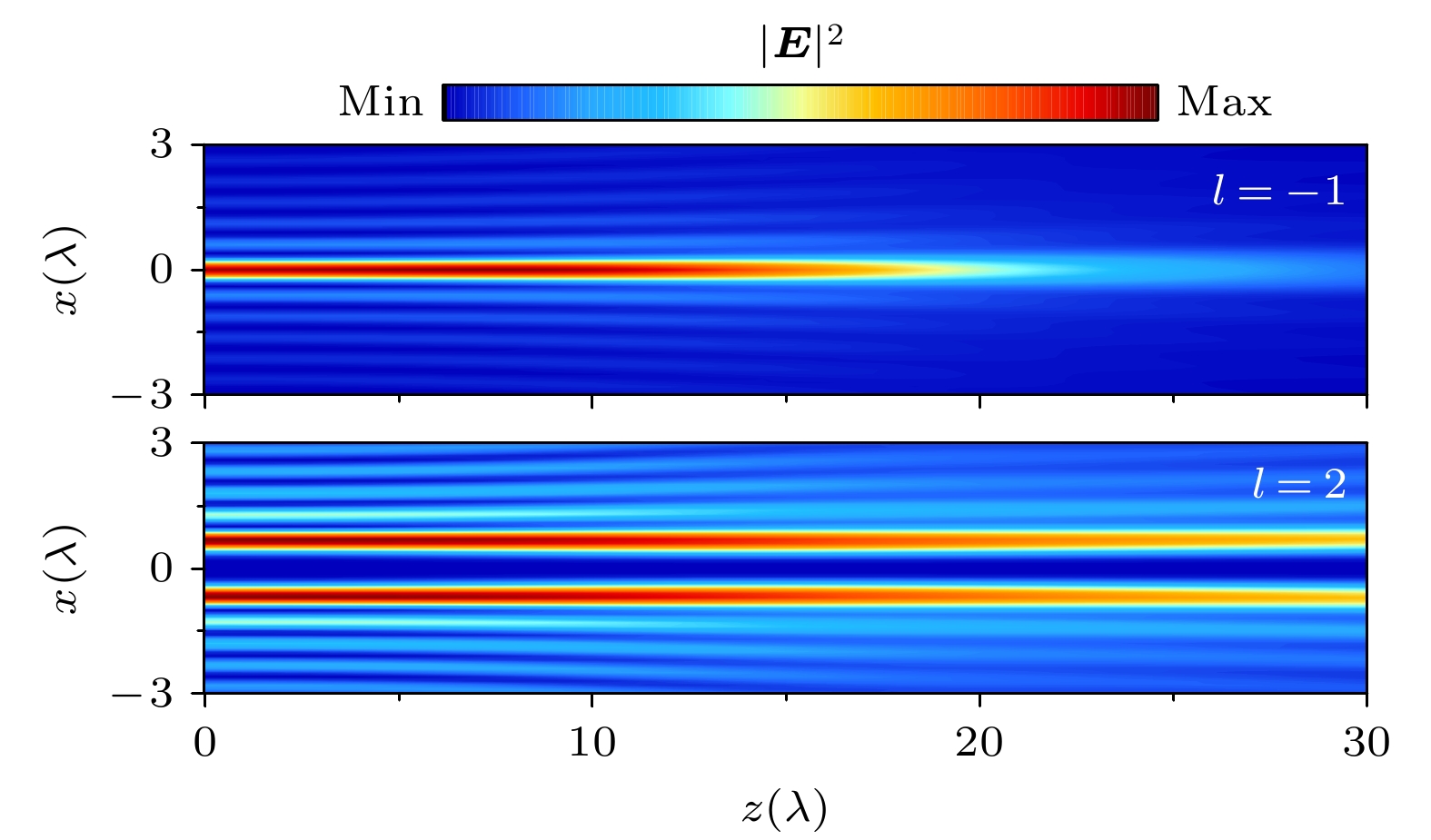
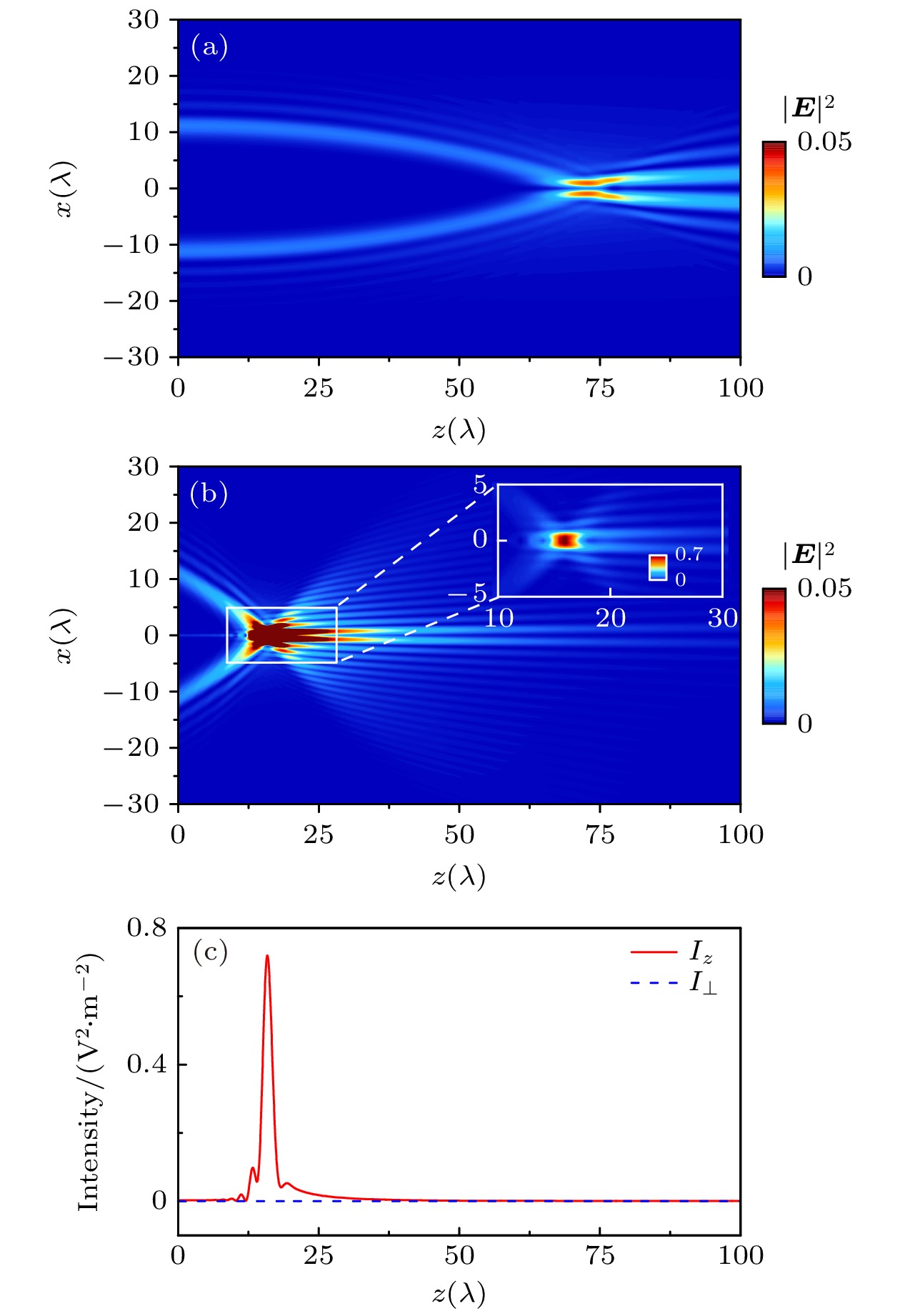
 下载:
下载:
